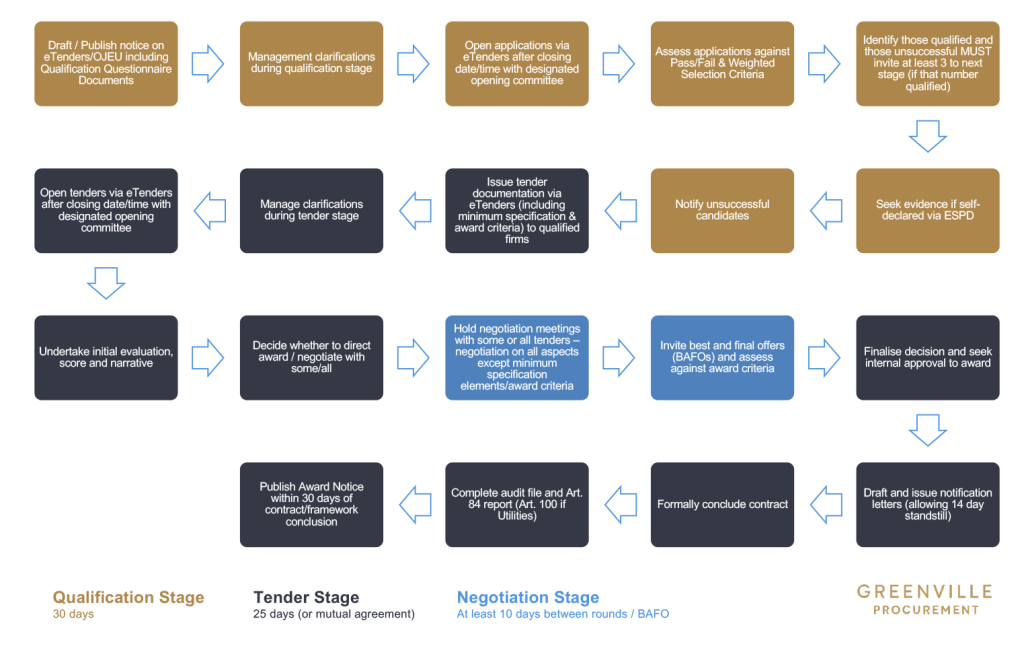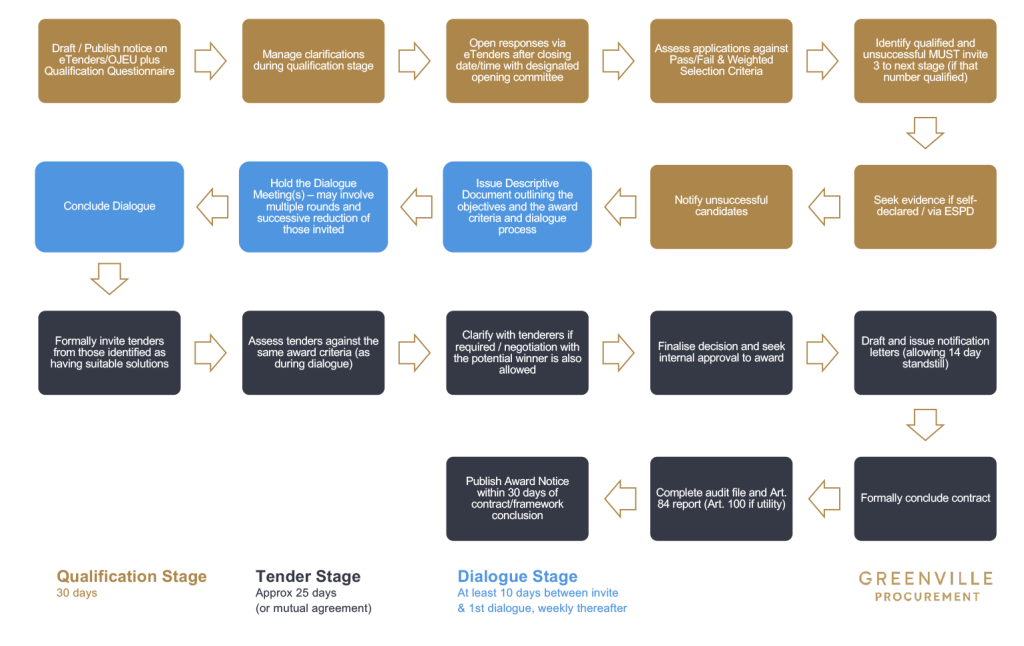
Deciding which Multi-Stage Competitive Procedure to choose
More and more public procurements are now identified strategically as involving risk and being classified as more complex. On that basis, public buyers are advised to identify the most appropriate procurement procedure that will deliver maximum results for the contracting authority. Despite inherent risks and the availability of poor specifications, many public buyers stick to the tried and tested open and/or restricted procedures. In our experience in Greenville Procurement, many of these procurements would be better suited to using either the competitive procedure with negotiation (negotiated if you are a Utility) or the competitive dialogue procedures.
Below we outline these two procedures.
1. Competitive Procedure with Negotiation

This is a procedure similar to the restricted procedure with the benefit of having the option to negotiate with one or more of the tenderers on all aspects of their submission including costs. The key feature is that, while the contracting authority can define a minimum specification, the procedure enables tenderers to offer additional functionality, features, etc. over and above that minimum with the additional benefit of being able to negotiate between the parties.
Like the restricted procedure, this procedure involves a qualification stage, followed by a tender stage, and then the ability to negotiate with those tenderers meeting the minimum requirements of the specification, with those negotiations allowed on all aspects of the tenders submitted – technical and cost – the only elements not open to negotiation are the minimum specification and the award criteria. Following the negotiation stage, best and final offers (BAFO) are then invited.
The benefit of the negotiation stage is that the tenderers and the contracting authority can get a better understanding of what is required/on offer with tenderers having the right to submit an improved bid at the BAFO stage.
If appropriate, the competitive procedure with negotiation also allows for a direct award on foot of initial tenders without negotiation, should the initial tenders received fully meet your requirements – this can be beneficial in many cases.
2. Competitive Dialogue Procedure

Alternatively, if the development of a minimum specification is a challenge, or indeed where multiple different solutions exist in the marketplace, the competitive dialogue procedure should be considered.
This procedure involves multiple stages –qualification stage, dialogue stage (descriptive document) and tender stage with the ability at the end of the tender stage to negotiate with some constraints regarding material change with the preferred bidder.
This procedure is ideal when the contracting authority does not / cannot develop a definitive specification of requirements, or alternatively, may be aware that there are multiple solutions available in the marketplace and does not wish to lead the specification of solutions in any one specific direction to the detriment of identifying the best solution.
The key feature of the dialogue stage is the provision of a descriptive document in advance issued to participants. This document contains a set of requirements, objectives, and goals for the procurement rather than a specification per se. Participants are invited to submit a response based on their unique solution to the requirements. This response is then the subject of dialogue meeting(s) to tease out solutions. Ultimately those participants identified with suitable solutions are invited to submit a tender focused on their individual solution. The process does not involve the identification of a common specification as is often thought, no cross-pollination of ideas should take place. Ultimately those invited to tender may well be offering very diverse solutions and this should be catered for in the invitation, either in the tender document and/or the covering invitation letter.
The same award criteria are applied during the dialogue and tender stages. An ideal criterion to use in this procedure when solutions are not necessarily known in advance is the “Fitness for Purpose of the Solution proposed”. Once the award decision has been reached, further clarification and negotiation may take place with the “preferred bidder”, so long as these discussions do not have the effect of materially modifying the tender or public procurement.
Conclusion
In our experience, these procedures are very effective and cater for a high degree of supplier engagement prior to the award decision. They are beneficial in IT procurements specifically, but can be used for any procurement involving risk, requirement to drive design and innovation in solutions and where significant clarity of requirements is not available to the contracting authority in advance. In summary, the competitive procedure with negotiation is suitable when a good minimum-based speciation is available and negotiation on cost / other aspects would be beneficial. The competitive dialogue works really well when the options in the market may be diverse when the contracting authority is unclear of the direction of solutions and/or when the contracting authority needs direction from the market on how to implement a viable solution.
Should you require assistance on these procedures Greenville Procurement has extensive experience having supported clients on over 100 such procedures across the full range of supplies, works and services, including contracts and framework agreements in the last three years alone.

Written by: Jeanne Copeland, CEO, Greenville Procurement

